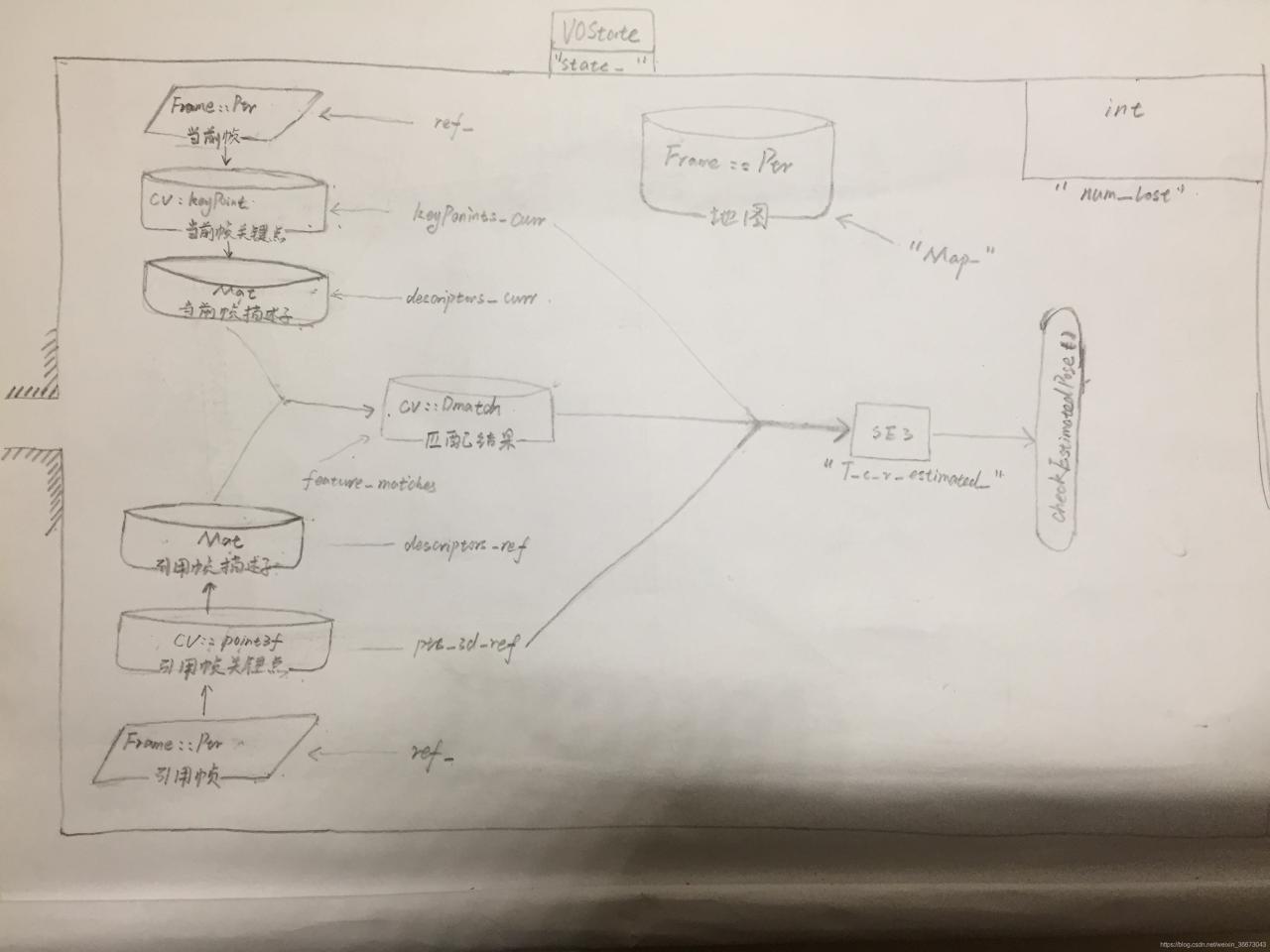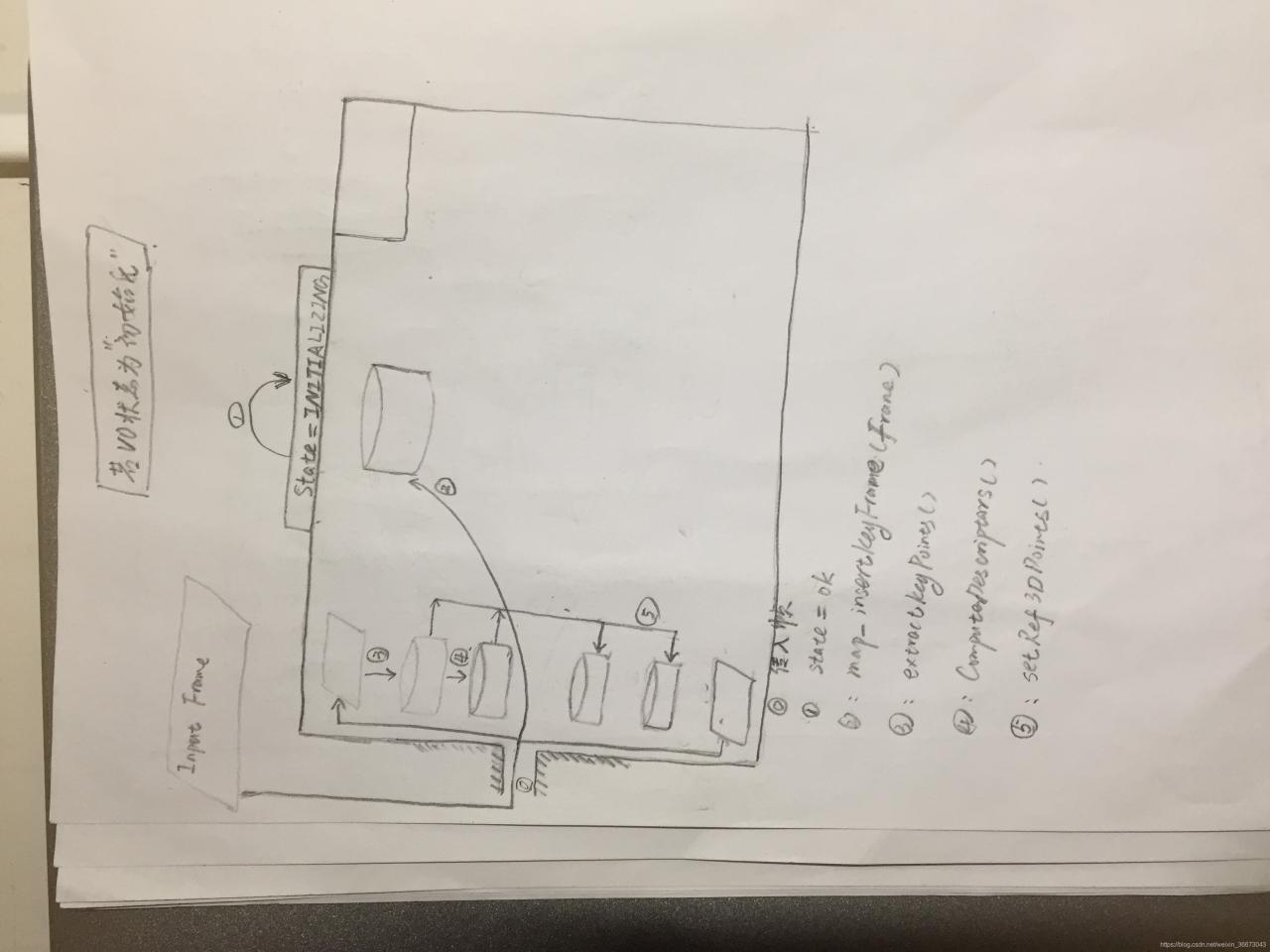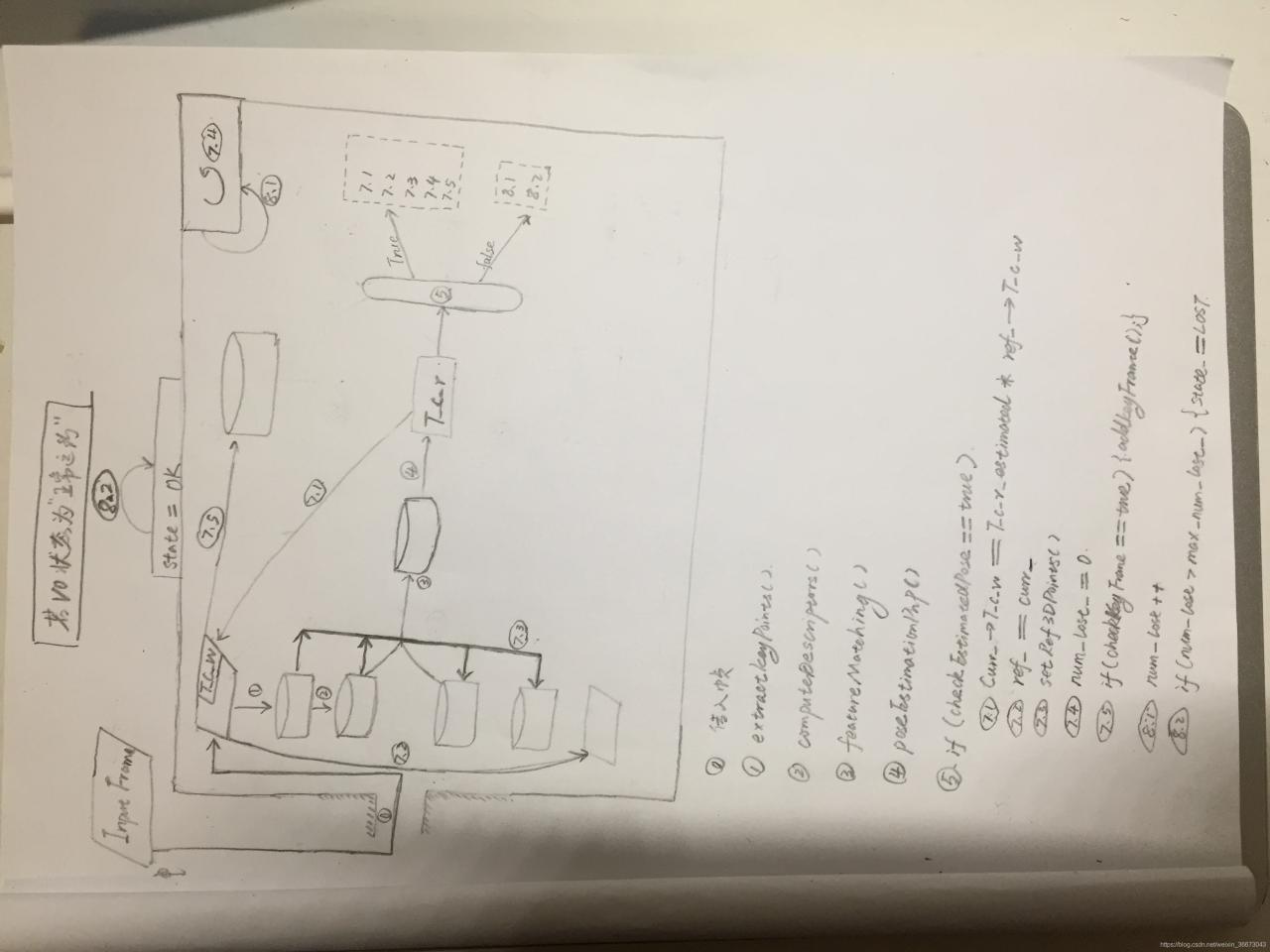逻辑框架——要素图

逻辑框架——流程图——>初始化状态

逻辑框架——流程图——>正常运转状态

头文件——/slam14/project/0.2/include/myslam/visual_odometry.h
/*
* <one line to give the program's name and a brief idea of what it does.>
* Copyright (C) 2016 <copyright holder> <email>
*
* This program is free software: you can redistribute it and/or modify
* it under the terms of the GNU General Public License as published by
* the Free Software Foundation, either version 3 of the License, or
* (at your option) any later version.
*
* This program is distributed in the hope that it will be useful,
* but WITHOUT ANY WARRANTY; without even the implied warranty of
* MERCHANTABILITY or FITNESS FOR A PARTICULAR PURPOSE. See the
* GNU General Public License for more details.
*
* You should have received a copy of the GNU General Public License
* along with this program. If not, see <http://www.gnu.org/licenses/>.
*
*/
#ifndef VISUALODOMETRY_H
#define VISUALODOMETRY_H
#include "myslam/common_include.h"
#include "myslam/map.h"
#include <opencv2/features2d/features2d.hpp>
namespace myslam
{
class VisualOdometry
{
public:
typedef shared_ptr<VisualOdometry> Ptr;
//枚举表征VO状态,初始化、正常、丢失
enum VOState {
INITIALIZING=-1,
OK=0,
LOST
};
//VO状态、地图(关键帧和特征点)、参考帧、当前帧
VOState state_; // current VO status
Map::Ptr map_; // map with all frames and map points
Frame::Ptr ref_; // reference frame
Frame::Ptr curr_; // current frame
//orb、当前帧特征点KeyPoint、当前帧描述子、参考帧3D坐标Point3f、参考帧描述子、匹配关系
cv::Ptr<cv::ORB> orb_; // orb detector and computer
// 当前帧的关键点,描述子存放位置
vector<cv::KeyPoint> keypoints_curr_; // keypoints in current frame
Mat descriptors_curr_; // descriptor in current frame
// 引用帧关键点,描述子存放位置
vector<cv::Point3f> pts_3d_ref_; // 3d points in reference frame
Mat descriptors_ref_; // descriptor in reference frame
// 当前帧vs引用帧匹配结果存放位置
vector<cv::DMatch> feature_matches_;
//位姿估计T、内点数(即为匹配出的关键点数量)、丢失数
SE3 T_c_r_estimated_; // the estimated pose of current frame 当前帧相对于参考帧的T
int num_inliers_; // number of inlier features in icp
int num_lost_; // number of lost times
//参数,特征数量、尺度、好匹配比率、最大持续丢失时间、最小内点数
// parameters
int num_of_features_; // number of features
double scale_factor_; // scale in image pyramid=图像金字塔比例尺
int level_pyramid_; // number of pyramid levels=金字塔层数
float match_ratio_; // ratio for selecting good matches = good matches 占比?
int max_num_lost_; // max number of continuous lost times=最大连续丢失帧数
int min_inliers_; // minimum inliers=
//关键帧筛选标准:最小旋转量&最小平移量,只要T满足其中一个即可
double key_frame_min_rot; // minimal rotation of two key-frames
double key_frame_min_trans; // minimal translation of two key-frames
public: // functions
VisualOdometry();
~VisualOdometry();
//核心,添加新关键帧
bool addFrame( Frame::Ptr frame ); // add a new frame
protected:
// inner operation
// 内部处理函数,特征匹配
void extractKeyPoints();
void computeDescriptors();
void featureMatching();
void poseEstimationPnP();
void setRef3DPoints();
// 关键帧的功能函数
void addKeyFrame();
bool checkEstimatedPose();
bool checkKeyFrame();
};
}
#endif // VISUALODOMETRY_H
源文件——/slam14/project/0.2/src/visual_odometry.cpp
/*
* <one line to give the program's name and a brief idea of what it does.>
* Copyright (C) 2016 <copyright holder> <email>
*
* This program is free software: you can redistribute it and/or modify
* it under the terms of the GNU General Public License as published by
* the Free Software Foundation, either version 3 of the License, or
* (at your option) any later version.
*
* This program is distributed in the hope that it will be useful,
* but WITHOUT ANY WARRANTY; without even the implied warranty of
* MERCHANTABILITY or FITNESS FOR A PARTICULAR PURPOSE. See the
* GNU General Public License for more details.
*
* You should have received a copy of the GNU General Public License
* along with this program. If not, see <http://www.gnu.org/licenses/>.
*
*/
#include <opencv2/highgui/highgui.hpp>
#include <opencv2/imgproc/imgproc.hpp>
#include <opencv2/calib3d/calib3d.hpp>
#include <algorithm>
#include <boost/timer.hpp>
#include "myslam/config.h"
#include "myslam/visual_odometry.h"
namespace myslam
{
VisualOdometry::VisualOdometry() :
state_ ( INITIALIZING ), ref_ ( nullptr ), curr_ ( nullptr ), map_ ( new Map ), num_lost_ ( 0 ), num_inliers_ ( 0 )
{
num_of_features_ = Config::get<int> ( "number_of_features" );// 特征点数量
scale_factor_ = Config::get<double> ( "scale_factor" ); // scale in image pyramid=图像金字塔比例尺
level_pyramid_ = Config::get<int> ( "level_pyramid" );// number of pyramid levels=金字塔层数
match_ratio_ = Config::get<float> ( "match_ratio" );// ?????ratio for selecting good matches = good matches 占比?
max_num_lost_ = Config::get<float> ( "max_num_lost" );// max number of continuous lost times=最大连续丢失帧数
min_inliers_ = Config::get<int> ( "min_inliers" );// 最少的内点数量???????
key_frame_min_rot = Config::get<double> ( "keyframe_rotation" );// ?????关键帧旋转??????
key_frame_min_trans = Config::get<double> ( "keyframe_translation" );// # ????关键帧变换??????
orb_ = cv::ORB::create ( num_of_features_, scale_factor_, level_pyramid_ );
}
VisualOdometry::~VisualOdometry()
{
}
bool VisualOdometry::addFrame ( Frame::Ptr frame )
{
switch ( state_ )
{
//1. 初始化状态,第一帧
case INITIALIZING://状态:初始化
{
state_ = OK;
curr_ = ref_ = frame;//当前帧和参考帧都是第一帧,实际上当前帧指向NULL也是行的。
map_->insertKeyFrame ( frame );//将此帧插入地图中
// extract features from first frame
//提取关键点和描述子
extractKeyPoints();//初始帧(当前帧)提取特征点
computeDescriptors();// 初始帧(当前帧)计算描述子
//当前帧转化成引用帧(说实话,我觉得这个函数没有写好,语义不是很清楚,语义介于“引用的坐标2D-->3D”和“利用当前帧生成引用帧”)
setRef3DPoints();// compute the 3d position of features in ref frame
break;
}
case OK:
{
curr_ = frame;
extractKeyPoints();//当前帧提取特征点
computeDescriptors();//当前帧计算描述子
//特征匹配并计算相机位姿 T
featureMatching();//当前帧vs引用帧,结果放入feature_matches_中
poseEstimationPnP();//pnp方法进行位姿估计(说明:未利用当前帧的深度信息)
//位姿估计好
if ( checkEstimatedPose() == true ) // a good estimation
{
//当前位姿 Tcw = Tcr*Trw
curr_->T_c_w_ = T_c_r_estimated_ * ref_->T_c_w_; // T_c_w = T_c_r*T_r_w
ref_ = curr_;//当前帧为参考帧
setRef3DPoints();//参考帧特征点的3D坐标,补全depth数据
num_lost_ = 0;//num_lost重置为0。
//检查是否为关键帧
if ( checkKeyFrame() == true ) // is a key-frame
{
addKeyFrame();
}
}
else // bad estimation due to various reasons
//位姿估计坏,丢失点计数+1,判断是否大于最大丢失数,是则VO状态切换为lost
{
num_lost_++;
if ( num_lost_ > max_num_lost_ )
{
state_ = LOST;
}
return false;
}
break;
}
case LOST://3. 匹配失败状态
{
cout<<"vo has lost."<<endl;
break;
}
}
return true;
}
// 当前帧提取特征点
void VisualOdometry::extractKeyPoints()
{
orb_->detect ( curr_->color_, keypoints_curr_ );//从curr_->color_中检测出keypoint放入keypoints_curr_
}
// 当前帧计算描述子
void VisualOdometry::computeDescriptors()
{
orb_->compute ( curr_->color_, keypoints_curr_, descriptors_curr_ );//计算curr_->color_中检测出的keypoint的descriptor
}
// 特征点匹配
void VisualOdometry::featureMatching()
{
// 关键点匹配:match desp_ref and desp_curr, use OpenCV's brute force match
vector<cv::DMatch> matches;//matches----->匹配结果存放地点(筛选前))
cv::BFMatcher matcher ( cv::NORM_HAMMING );
matcher.match ( descriptors_ref_, descriptors_curr_, matches );
// 关键点筛选:select the best matches
//找到matches数组中最小距离,赋值给min_dist
float min_dis = std::min_element (
matches.begin(), matches.end(),
[] ( const cv::DMa tch& m1, const cv::DMatch& m2 )
{
return m1.distance < m2.distance;
} )->distance;
feature_matches_.clear();//清除上次匹配结果
//根据距离筛选特征点
for ( cv::DMatch& m : matches )
{
if ( m.distance < max<float> ( min_dis*match_ratio_, 30.0 ) )
{
feature_matches_.push_back(m);//符合条件的匹配放入feature_matches_
}
}
cout<<"good matches: "<<feature_matches_.size()<<endl;
}
// 引用帧3D点设置
//pnp需要参考帧3D,当前帧2D,所以当前帧迭代为参考帧时,需要加上depth数据
// 每轮循环结束,都需要把当前帧变成参考帧,这时候就需要把当前帧的坐标的2D形式转化成3D形式
void VisualOdometry::setRef3DPoints()
{
// select the features with depth measurements
pts_3d_ref_.clear();
descriptors_ref_ = Mat();
//遍历当前关键点数组遍历
for ( size_t i=0; i<keypoints_curr_.size(); i++ )
{
//找到depth数据
double d = ref_->findDepth(keypoints_curr_[i]);
if ( d > 0)
{
//像素坐标到相机坐标系3D坐标
Vector3d p_cam = ref_->camera_->pixel2camera(//这一块,用curr_->camera也是可以的,因为相机是一样的
Vector2d(keypoints_curr_[i].pt.x, keypoints_curr_[i].pt.y), d
);
//构造Point3f,3D坐标
pts_3d_ref_.push_back( cv::Point3f( p_cam(0,0), p_cam(1,0), p_cam(2,0) ));
//参考帧描述子,将当前帧描述子按行放进去。
descriptors_ref_.push_back(descriptors_curr_.row(i));
}
}
}
// 使用pnp进行位置估计
// PnP估计相机位姿T
// 使用pts_3d_ref_ 、keypoints_curr_、feature_matches_、相机参数----->estimate出相机的T
void VisualOdometry::poseEstimationPnP()
{
// construct the 3d 2d observations
//参考帧3D坐标和当前帧2D坐标(需要.pt像素坐标)
vector<cv::Point3f> pts3d;
vector<cv::Point2f> pts2d;
for ( cv::DMatch m:feature_matches_ )
{
pts3d.push_back( pts_3d_ref_[m.queryIdx] );//query=ref
pts2d.push_back( keypoints_curr_[m.trainIdx].pt );//train=curr
}
//相机内参不变
Mat K = ( cv::Mat_<double>(3,3)<<
ref_->camera_->fx_, 0, ref_->camera_->cx_,
0, ref_->camera_->fy_, ref_->camera_->cy_,
0,0,1
);
//旋转、平移、内点数组
Mat rvec, tvec, inliers;
//核心函数
cv::solvePnPRansac( pts3d, pts2d, K, Mat(), rvec, tvec, false, 100, 4.0, 0.99, inliers );
// 猜测内点数,应该是匹配出的特征点中真正被位姿估计函数使用的那些点
num_inliers_ = inliers.rows;
cout<<"pnp inliers: "<<num_inliers_<<endl;
//由旋转和平移构造出当前帧相对于参考帧的T
T_c_r_estimated_ = SE3(
SO3(rvec.at<double>(0,0), rvec.at<double>(1,0), rvec.at<double>(2,0)),
Vector3d( tvec.at<double>(0,0), tvec.at<double>(1,0), tvec.at<double>(2,0))
);
}
// 位置估计检查,
//位姿检验模块,匹配点不能太少,运动不能太大
bool VisualOdometry::checkEstimatedPose()
{
// check if the estimated pose is good
//匹配点太少,false
if ( num_inliers_ < min_inliers_ )
{
cout<<"reject because inlier is too small: "<<num_inliers_<<endl;
return false;
}
// if the motion is too large, it is probably wrong
//T的模太大,false
Sophus::Vector6d d = T_c_r_estimated_.log();
if ( d.norm() > 5.0 )
{
cout<<"reject because motion is too large: "<<d.norm()<<endl;
return false;
}
return true;
}
// 检查关键帧,T中R或t比较大都是关键帧
bool VisualOdometry::checkKeyFrame()
{
Sophus::Vector6d d = T_c_r_estimated_.log();
Vector3d trans = d.head<3>();
Vector3d rot = d.tail<3>();
if ( rot.norm() >key_frame_min_rot || trans.norm() >key_frame_min_trans )
return true;
return false;
}
// 添加关键帧
void VisualOdometry::addKeyFrame()
{
cout<<"adding a key-frame"<<endl;
map_->insertKeyFrame ( curr_ );
}
}非常糙的初步版本,后面有时间再优化!
版权声明:本文为weixin_36673043原创文章,遵循 CC 4.0 BY-SA 版权协议,转载请附上原文出处链接和本声明。